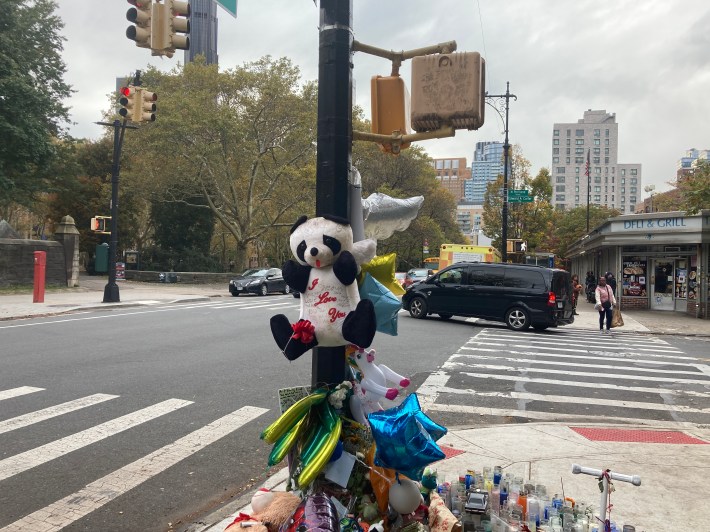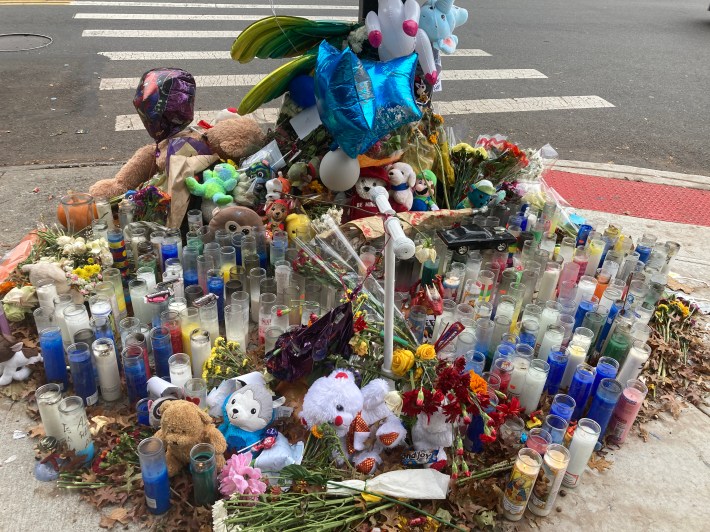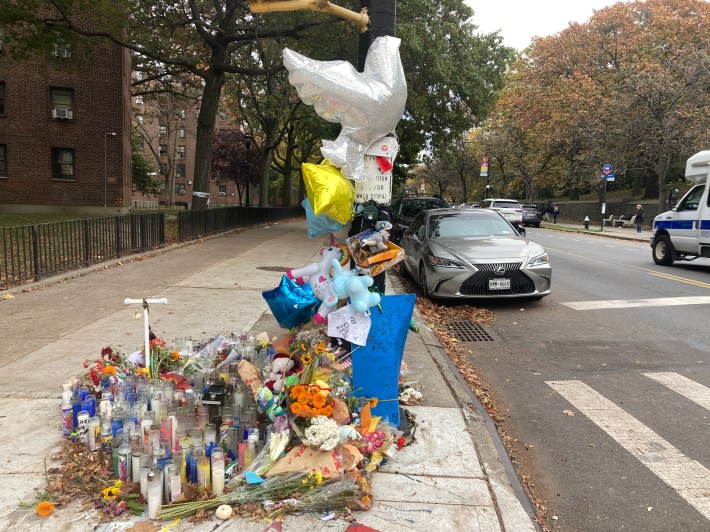It shouldn't take a death.
The Adams administration said it will redesign the intersection where 7-year-old Kamari Hughes was killed days earlier, even as critics blamed the mayor for not doing enough to keep roads safe in a year when nine children and a record number of cyclists have died in crashes.
Deputy Mayor Meera Joshi said at the mayor's "Off-Topic Tuesday" presser that the Department of Transportation had, earlier that morning, changed the light timing to give pedestrians more time at North Portland and Myrtle avenues. She added that the agency would also soon break ground on a more robust redesign, including adding in loading zones and daylighting, which clears intersections of parked cars that block visibility.
Meanwhile, Mayor Adams testily defended his record on street safety amid demands from parents for "leadership that cares" about pedestrians.
“This administration is not sitting on its hands, and really the journey around safe streets didn't start last week — it was my advocacy that dropped down the speed limits in this city, it was my advocacy that made safe streets for years,” Adams said. “People want to reinvent my history. I have a long history on street safety and I'm going continue to advocate for that.”

Council Member Selvena Brooks-Powers (D-Queens) had earlier called for more daylighting.
“This is just the latest painful incident underscoring the need for additional investments in street safety, such as by daylighting intersections, a proven safety measure that increases visibility to oncoming traffic at intersections and reduces danger for pedestrians and drivers alike,” Brooks-Powers said in a statement.
The changes at the corner are similar to improvements made after 7-year-old Dolma Naadhun was killed by a reckless driver at an intersection in Queens that lacked daylighting to accommodate more parking. But back in Fort Greene, a memorial shrine was being built for Kamari.
Children dressed up in Halloween costumes stopped by to pay their respects, leaving pieces of candy for their friend, neighbor, classmate where he was killed, a corner that includes candles, stuffed animals, and a little white ghost scooter.

The leading pedestrian interval mentioned by Joshi had in fact been installed, Streetsblog confirmed, but cars were still parked as close to the intersection as possible, even illegally encroaching on the marked crosswalk. State law prohibits drivers from parking within 20 feet of a crosswalk, but it also gives New York City permission to exempt itself from enforcing that provision. (The DOT declined to say when work will commence on adding daylighting and loading zones.)

One father who was pushing his daughter in a stroller said the city should be more proactive when it comes to street safety, rather than reactive.
“It shouldn’t take a tragedy for things like that to happen,” said James, who declined to provide his last name, adding that “there’s schools everywhere” in the neighborhood.
And another parent walking by with her son said she doesn’t understand why there is no school crossing guard at that intersection — a job that data show is “very dangerous,” Streetsblog recently reported.
“This should have been prevented,” said Rachel, a school teacher a block away, who declined to provide her last name.
Danny Harris, the executive director of Transportation Alternatives, charged the administration with only acting after a high-profile death.
“Only after a 7-year-old was killed will the City of New York daylight this intersection," he said. "To keep our kids safe, Mayor Adams needs to bring daylighting to every intersection across the five boroughs. No family should have to suffer a preventable loss when the City of New York has every tool, but the political will, to keep them safe."
Officials pushed back on the idea that they only make changes after such tragedies, saying they’ve daylighted 299 intersections so far this year — far more than the 100 that the DOT will eventually have to install every year under Council legislation passed back in May. The DOT declined to provide a list of those intersections.
Joshi also said the city is focused not only on removing cars from intersections to improve visibility, but also replacing them with other physical barriers such as a bike rack or planter that forces drivers to slow down when turning.
“We’re committed to really hitting all of our highest crash corners, as well as those corners near schools, to ensure that there's daylighting as well as hardening with that daylighting, because ... if we don't put something in there to block it, like a planter, then often cars come in and undo the good work that daylighting does,” she said.
Speaking of undoing good work, Adams has done some of that himself, recently saying that he would first conduct door to door surveys before completing a nearly-finished safety improvement on nearby Underhill Avenue. And he previously scaled back street safety improvements on Ashland Place and McGuinness Boulevard, in deference to local business interests.
In response @julcuba at Off-Topic Tuesday, Meera Joshi says some improvements are being made today where Kamari Hughes was killed last week. But such safety efforts always seem to require a death before installation. Parents want more as 9 kids have died: https://t.co/RtlzS193j9 pic.twitter.com/m6QZLsztmp
— Streetsblog New York (@StreetsblogNYC) October 31, 2023
And on the enforcement side, Joshi added that the NYPD is stepping up its ticketing of reckless drivers, particularly for infractions like blocking crosswalks, double parking, and failure to yield. But Streetsblog crunched the numbers in those three categories and discovered that enforcement is way down since 2019, so it's unclear what NYPD enforcement Joshi might have meant:






